Rabbit Pee: The Colourful Key To Your Bunny’s Health
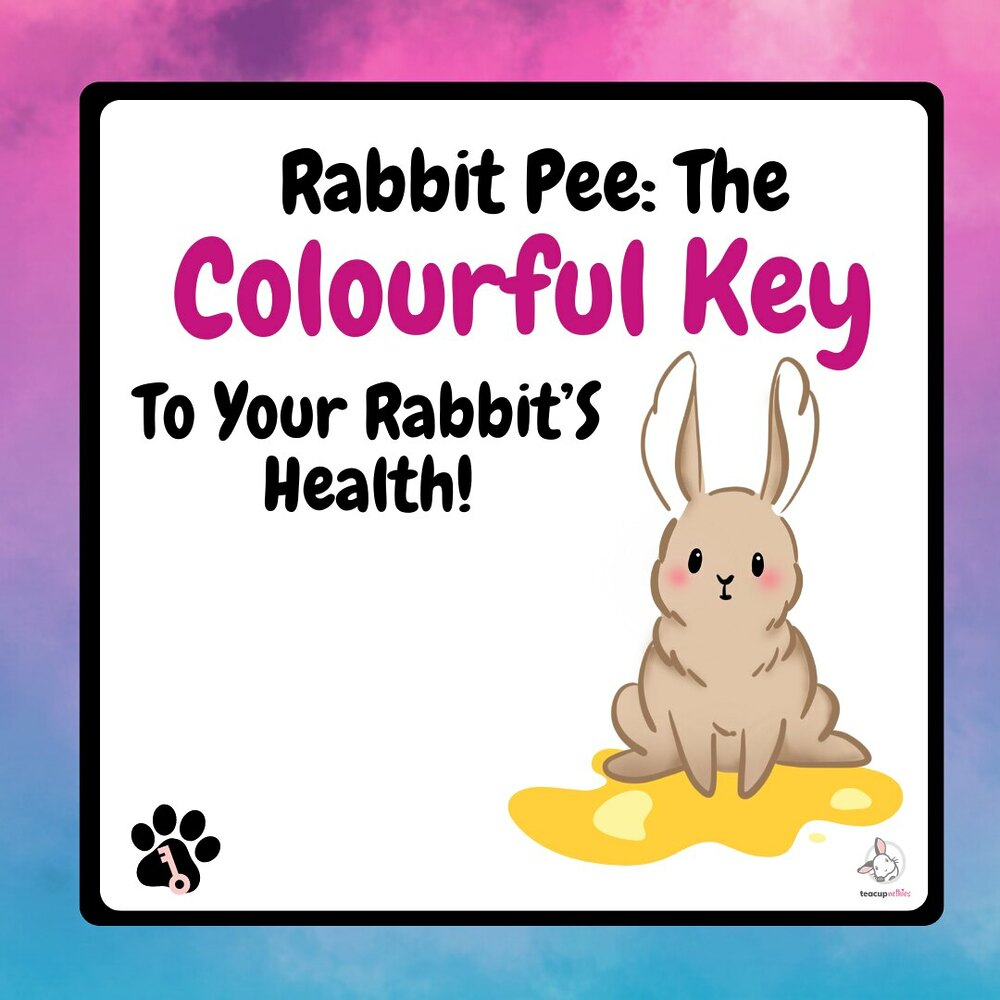
All creatures urinate, rabbits included. Similar to people, the appearance of a rabbit’s urine can change based on what they’ve eaten and their water intake. But what if the urine appears red or even white? Surely, that’s not typical, right?
Typically, the urine of a rabbit ranges from yellow to golden orange. However, red, brown, or white urine, while potentially concerning, may still be normal for your rabbit. It’s important to consult your veterinarian about these colours. The presence of sand-like particles or actual blood in the urine is a more serious sign, indicating potential health issues. If you’re concerned about the state of your rabbit’s urine, this guide will walk you through what’s considered normal and when it’s advisable to seek a professional, often referred to affectionately as the rabbit doctor.
Colour of Rabbit Pee (urine)
Rabbit urine can exhibit a range of colours while remaining healthy. Rabbits typically urinate between 2 to 8 times daily, with the urine being golden yellow or amber in hue.Should a rabbit experience dehydration, its urine may appear darker and more concentrated. Additionally, the urine’s colour can vary with the rabbit’s diet. For instance, consuming a large amount of carrots might result in a noticeably brighter orange urine.While normal rabbit urine might appear slightly cloudy due to the excretion of excess calcium, overly cloudy or murky urine can indicate a more serious condition affecting the bladder.
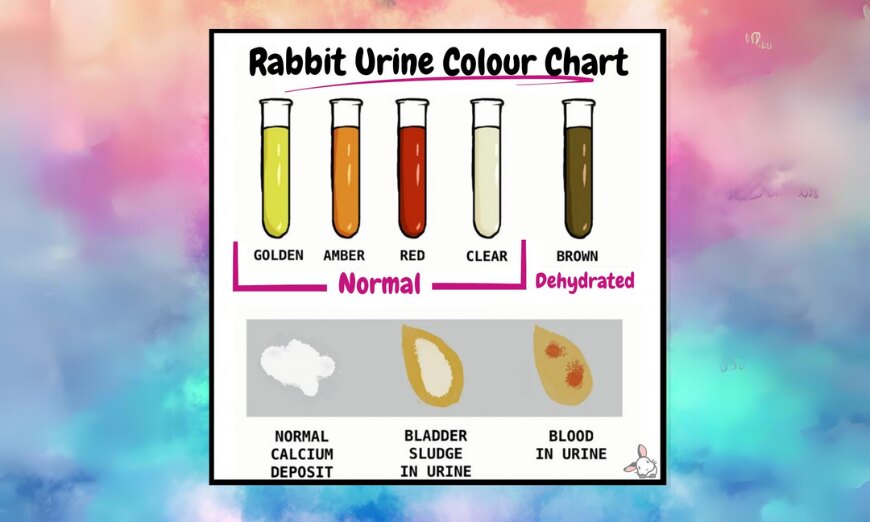
Your rabbit’s urine can come in various shades including golden, amber, red, and even clear. If the urine appears brown or especially dark, it’s often a sign that your rabbit may be slightly dehydrated. When you notice white ‘urine,’ it’s typically just a calcium deposit, which is not a cause for alarm. However, spotting sediment or sand-like particles, known as bladder sludge, in your rabbit’s urine should raise concern. The presence of blood in the urine is quite rare, but it’s distinguishable by spotted rather than uniformly red appearances.
Rabbit Pee Colour Chart
| Yellow | This is normal pee. |
| Orange | This is normal pee, but your rabbit might be slightly dehydrated. Try encouraging them to drink more water. |
| Red | Usually there is no need to worry.This is probably caused by food in your rabbit’s diet. The colour will usually return back to normal within a week. |
| Brown | Possibly dehydrated, encourage your rabbit to drink more water. |
| Transparent | This is normal pee. If your rabbit’s pee isn’t usually transparent, pay attention to see if their drinking habits have changed. Excessive drinking may be a sign of kidney problems in rabbits. |
| Red spots | This could be a sign of blood in your rabbit’s urine. But it could also be from food in your rabbits diet. Check with your vet to see if there are any health problems that need to be addressed. |
| White | Occasional white discharge is normal for rabbits. It is how your rabbit releases excess calcium from their diets. If this is a frequent occurrence, check with your vet to make sure there are no underlying conditions to be concerned about. |
| Cloudy | If your rabbit has cloudy or chalky pee, this is a sign of bladder stones or a urinary tract infection. It’s best to get your rabbit to the vet as soon as you can. |
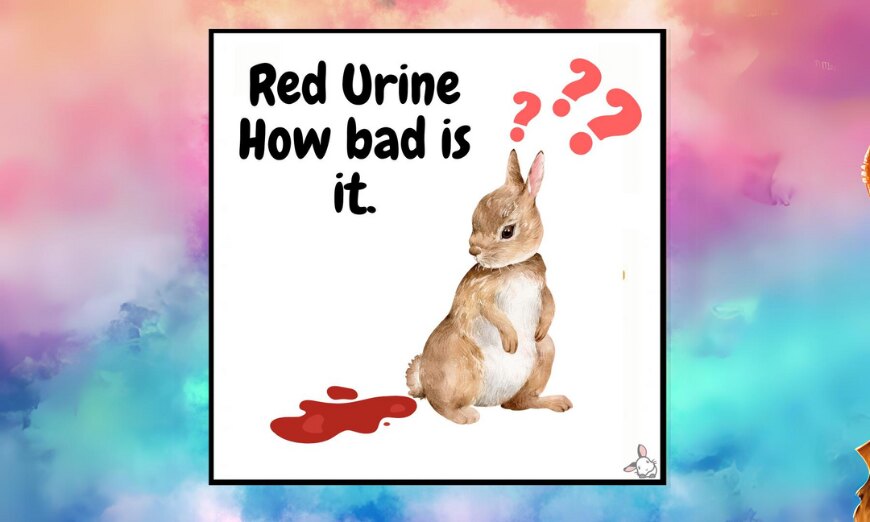
Red pee — when is it bad?
Red Urine in Rabbits — When Should You Be Concerned? Generally, red urine in rabbits isn’t a major cause for alarm. Though not the typical hue for rabbit urine, it’s seldom an indicator of health issues.If the urine displays a uniform, consistent shade of red, whether bright or dark, it’s highly unlikely to be due to blood. Blood presence in rabbit urine is rare, and when it occurs, it tends to manifest as spots rather than a consistent colour throughout.What Could Cause Red Urine in Rabbits?
Antibiotics: The colour of a rabbit’s urine might change to red during antibiotic treatments.
Seasonal Changes: Some rabbits may exhibit red urine for a few days when the weather starts getting colder in the fall.
Diet: Consuming foods high in beta carotene (like carrots and spinach) or red berries (such as strawberries and raspberries) can lead to a reddish tint in their urine.
Hydrogen Peroxide Test for Detecting Blood in Rabbit Urine If concerns persist about the presence of blood in your rabbit’s urine, or if the urine hasn’t reverted to its usual golden or amber shade after several weeks, a hydrogen peroxide test can help confirm if blood is present.To conduct this test, collect a sample of your rabbit’s urine and add a small amount of hydrogen peroxide to it. Normally, hydrogen peroxide won’t react with urine that doesn’t contain blood. However, if blood is present, you’ll notice the mixture beginning to foam, indicating a positive result for blood.
Orange or Brown Rabbit Urine:
Concerns and Hydration Tips Orange or brown urine in rabbits is typically not a cause for alarm. Such colours can be perfectly normal, though they may also indicate slight dehydration.A darker, more concentrated urine often suggests reduced water intake. However, if your rabbit doesn’t seem distressed, there’s no immediate need for worry. Nevertheless, encouraging more water consumption can be beneficial.
To aid in keeping your rabbit well-hydrated, consider these strategies:
Opt for a Water Bowl: Rabbits tend to drink more from a bowl than a bottle, so switching to a bowl for water can increase their intake.
Provide Fresh Leafy Greens: These vegetables are high in water content, aiding hydration. Leaving extra water droplets on them after washing can also encourage more water consumption.
Refresh Water Regularly: Changing the water in your rabbit’s bowl with cool, fresh water multiple times a day can spark their interest in drinking.Introduce a Running Water Fountain: A pet water fountain keeps water flowing, which can be more appealing to rabbits and ensure the water tastes fresh.
Flavour the water lightly: Adding a few drops of unsweetened apple or carrot juice can make the water more enticing with a subtle, sweet taste.
White or Milky Rabbit Urine:
Understanding Calcium Excretion Rabbits may occasionally pass a white, milky substance along with their urine, indicative of excess calcium being expelled from the body. This is a natural process, resulting in a chalky white residue once dried. Rabbits efficiently absorb calcium from their diet, often maintaining higher blood calcium levels compared to many other pet animals. They consume as much calcium as their diet allows and then eliminate any surplus through their urine.
Finding white spots in your rabbit’s litter box now and then is completely normal. However, if this occurs with great frequency, it might be an indicator that your rabbit’s diet contains too much calcium. For adult rabbits, it’s advisable to switch from alfalfa-based hays or pellets, which are rich in calcium, to timothy hay alternatives more suited to their nutritional needs.
Frequent calcium excretion in rabbits may also warrant a veterinary consultation to rule out any underlying health concerns.
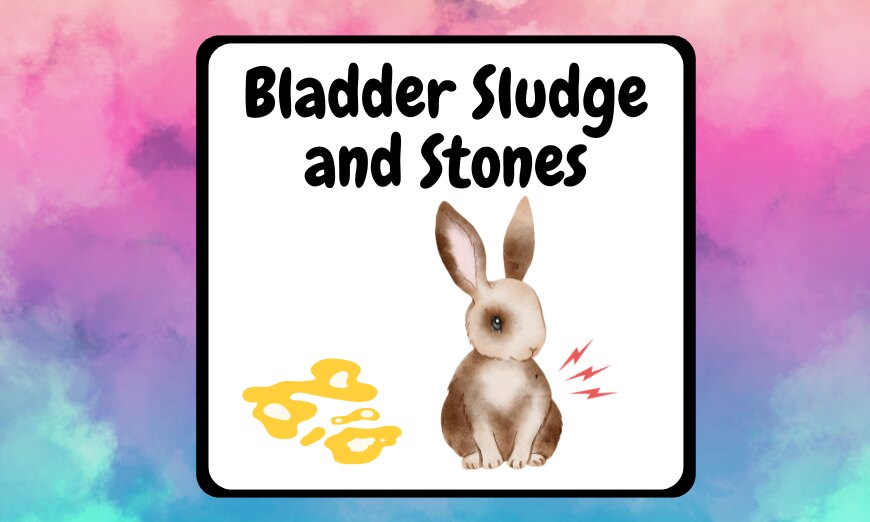
Bladder sludge and bladder stones
Common Rabbit Urinary Issues:
Bladder Stones and Sludge in rabbits, bladder stones and bladder sludge are among the most common urinary health concerns. Bladder stones arise from accumulations of excess calcium that solidify into stones within the kidneys and ureters. Bladder sludge is a similar condition where the calcium thickens but doesn’t fully solidify into stones. These conditions can cause discomfort or pain to a rabbit and, if left untreated, may progress to more severe health problems. Both bladder stones and sludge could also indicate an underlying bladder or kidney infection, emphasizing the importance of prompt veterinary care at the first sign of trouble. A veterinarian can conduct necessary tests to diagnose these conditions accurately and recommend the most effective treatment plan for your rabbit’s specific needs.
Indicators of Bladder Sludge and Stones in Rabbits
Detecting early signs of bladder sludge in rabbits can be challenging, as initial symptoms are minimal. However, as the condition worsens, several symptoms may emerge, including:
Increased Frequency of Urination: Your rabbit may begin urinating more often than usual, possibly in smaller amounts each time. While a healthy rabbit typically urinates 2-8 times a day, variations from your rabbit’s normal pattern could signal a problem.
Urinating Outside the Litter Box: A deviation from usual litter box habits, especially in a rabbit that’s litter-trained, might indicate bladder issues. This is distinct from spraying behaviour seen in rabbits that aren’t neutered.
Dribbling Urine: An inability to control bladder functions or dribbling urine suggests possible bladder sludge or stones.
Difficulty Urinating: A rabbit struggling to urinate or not urinating at all, especially if it adopts a strained posture as if trying to urinate but only manages a trickle, could be experiencing bladder sludge or stones. Immediate emergency care may be required if a stone is blocking the urethra.
Presence of Sludge: Sludge can give urine a cloudy, murky appearance. Once dry, it leaves a rough, grey, chalky residue, sometimes with a sandy texture, and can stain the fur around the rabbit’s hindquarters.
Urine Scald: This is a rash caused by prolonged urine contact, particularly if a rabbit with bladder issues is dribbling urine, leading to wet fur on the hindquarters and legs. The constant dampness can irritate the skin, resulting in a condition known as urine scald.
Potential Causes of Bladder Stones in Rabbits
The precise cause of bladder stones in rabbits isn’t entirely known, but certain risk factors may contribute to the development of this condition. These include:
Genetics: Some rabbits may be genetically predisposed to producing bladder stones or sludge, indicating a hereditary component to the risk.
Insufficient Water Intake: Proper hydration helps maintain dilute urine, facilitating the excretion of excess calcium. A lack of adequate water intake can result in calcium accumulation in the kidneys, complicating its passage.
Lack of Physical Activity: Limited movement can predispose rabbits to the formation of calcium crystals. Inactivity can reduce the frequency of drinking and urination, allowing calcium more time to crystallize in the urinary tract.
Improper Living Conditions: Small or unclean living spaces can discourage rabbits from being active or urinating as needed, promoting the formation of calcium crystals due to less frequent urination.
Kidney Disease: In some cases, bladder stones and sludge may indicate underlying kidney disease, with the stones being a symptom rather than a primary condition.
Bladder Disease: Diseases of the bladder, including infections, tumours, or inflammation, can lead to the development of bladder stones and sludge.
High Calcium Diet: While a diet rich in calcium can contribute to the formation of bladder stones and sludge, it’s typically not the only factor involved.
Preventative Measures for Bladder Stones in Rabbits
Despite our best efforts, some rabbits may still develop bladder stones. However, there are several strategies to reduce the likelihood of this condition in your pet rabbit:
Promote Increased Water Consumption: Keeping urine diluted by encouraging your rabbit to drink more water is crucial. Take measures to ensure your rabbit remains well-hydrated.
Eliminate Alfalfa-Based Foods: Foods based on alfalfa are high in calcium and not recommended for adult rabbits (though they can be suitable for younger ones). Review the ingredients in your rabbit’s pellets and switch to a timothy hay-based option.
Incorporate Fresh Leafy Greens: Including plenty of fresh leafy greens in your rabbit’s diet can help maintain their health and hydration.
Encourage Physical Activity: Regular exercise helps keep a rabbit’s system functioning optimally and promotes water intake.
Maintain Cleanliness of the Litter Box: A clean litter box encourages regular use, which can help prevent the accumulation of calcium crystals by ensuring consistent urination.
Regular Veterinary Visits: Annual check-ups with a veterinarian can detect early signs of potential health issues, including those related to urinary health.
Managing Urinary Tract Infections in Rabbits
Another prevalent issue affecting rabbit urinary health is the urinary tract infection (UTI), also referred to as Cystitis. This condition involves inflammation of the bladder triggered by a bacterial infection, making urination uncomfortable or painful for the affected rabbit.
Should you suspect a UTI in your rabbit, it’s important to seek veterinary care. A veterinarian can conduct tests to identify the cause of your rabbit’s symptoms and recommend an appropriate antibiotic treatment to address the infection.
Identifying a UTI in Rabbits
The symptoms of a urinary tract infection (UTI) in rabbits can closely resemble those associated with bladder sludge, and it’s not uncommon for both conditions to occur simultaneously. This is because the accumulation of bladder sludge can sometimes lead to a bladder infection.
Key signs to watch for if you suspect your rabbit might have a UTI include:
- Urinating more frequently but in small amounts each time.
- Struggling or appearing constipated when attempting to urinate.
- Presence of thick sludge within the urine.
- Urine scalding, where the skin is irritated by prolonged contact with urine.
- Grunting or showing signs of discomfort while urinating.
- Weight loss without an obvious reason.
- A reluctance to move or reduced activity levels.
- The appearance of blood within the urine, indicating a possible infection or other serious condition.
Causes of UTIs in Rabbits
Urinary tract infections (UTIs) in rabbits are primarily triggered by bacterial accumulation that leads to inflammation or blockage in the bladder and urinary tract.
This infection often originates from one of two sources: the most common cause is obstruction by bladder stones or sludge, which leads to urinary retention and subsequent bacterial buildup. A less frequent but serious cause is injury to the ureters, often due to cancerous growths, which can also facilitate an environment conducive to bacterial growth.
Preventing UTIs in Rabbits
Preventative measures against UTIs in rabbits align closely with those recommended for preventing bladder sludge accumulation:
- Ensure access to fresh, clean drinking water at all times to promote regular urination and dilute the urine, lessening the risk of sludge and stone formation.
- Provide a diet rich in fresh leafy greens, which are high in water content to aid hydration and overall urinary health.
- Encourage regular exercise to stimulate metabolism and urinary function, helping to prevent the stasis that can lead to sludge formation.
- Maintain a clean litter box to encourage regular urination, preventing the buildup of bacteria that can lead to UTIs.
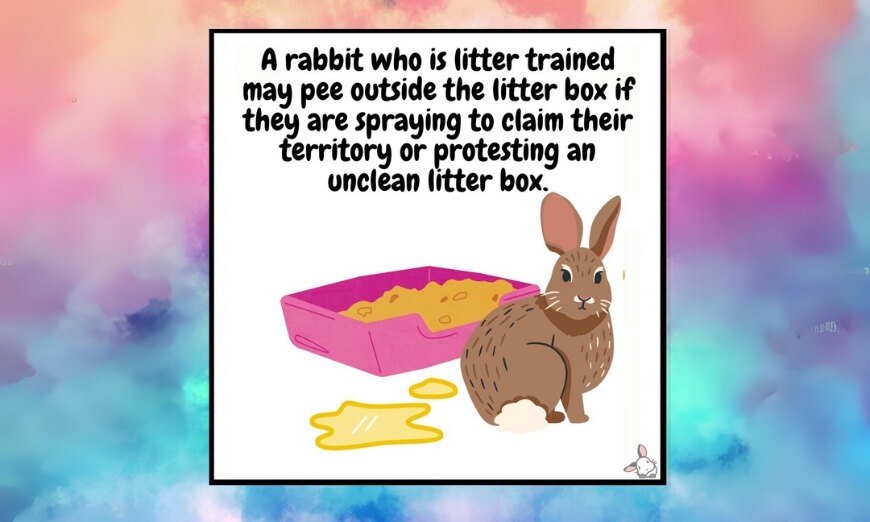
Peeing outside of the litter box
Litter Box Habits and Health Signals in Rabbits Though your rabbit may be litter box trained, instances of urinating outside the litter box can occur. Such behaviour can sometimes signal medical concerns, particularly if observed alongside symptoms like frequent, scant urination or dribbling. However, deviation from established litter box routines doesn’t always point to a health crisis.
Territorial Spraying in Rabbits
Unneutered rabbits, known for their territorial instincts, often engage in spraying urine around their environment as a means of marking territory. While this behaviour is more commonly observed in males, females may exhibit it as well. Typically, rabbits prefer to spray on vertical surfaces to assert their presence, though preferences can vary with the individual’s personality.
The most effective solution to mitigate territorial spraying is to have your rabbit spayed or neutered. This procedure not only addresses various behavioural issues, including spraying, but also contributes to the overall health and well-being of your rabbit.
Rabbits Urinating on Beds
It’s a known issue among rabbit owners that some rabbits, even those that have been spayed or neutered, may jump onto their owner’s bed and urinate on the sheets. This behaviour doesn’t occur with every rabbit, but it’s not uncommon. It’s theorised that rabbits do this because the bed carries the owner’s scent strongly, triggering their territorial instincts to mark it as their own with urine.
Preventing this specific behaviour can be challenging. If your rabbit has a habit of urinating on the bed, the most straightforward solution might be to restrict their access to the bed entirely. This approach helps avoid the frequent need to clean urine stains from your bedding.
Rabbits and Cleanliness: Litter Box Maintenance
Rabbits may choose to urinate outside their litter box as a form of protest against a dirty litter box, often opting to do so right beside it. This behaviour stems from their desire for cleanliness, preferring to confine messes to a single area within their habitat. However, a litter box that is too unclean may compel them to eliminate elsewhere.
The clear remedy to avoid such behaviour is regular maintenance of your rabbit’s litter box. Daily cleaning not only encourages consistent litter box use but also serves as a preventive measure against urinary infections and urine scald, contributing to the overall health and well-being of your rabbit.
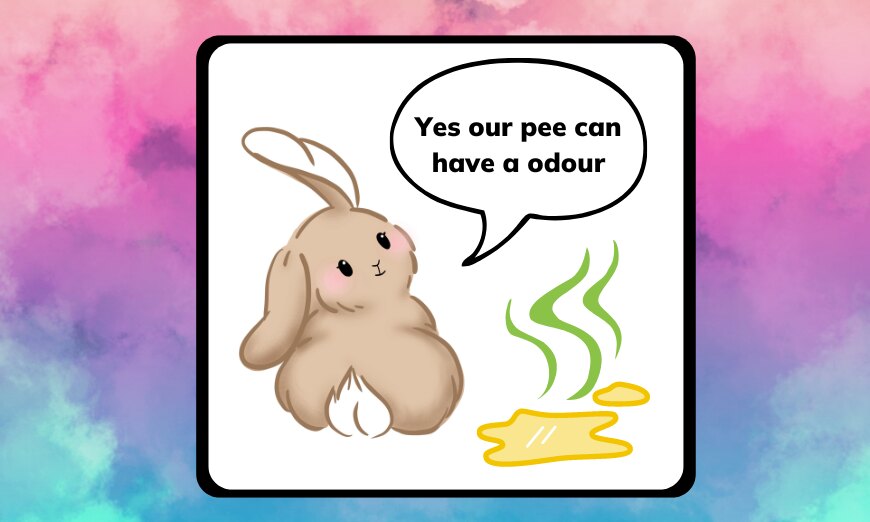
Does Rabbit Urine Have a Strong Odour?
Yes, rabbit urine does emit a distinctive smell, primarily due to its relatively high ammonia content, which can give it a diluted ammonia-like scent. This is often the most notable odour associated with pet rabbits.
Once you manage the smell of rabbit urine, your home should largely be free from any strong animal odours.
Here are some steps to help minimize the scent of rabbit urine in your home:
Spaying or Neutering: The urine of spayed or neutered rabbits tends to have a slightly less potent smell.
Daily Litter Box Cleaning: Regularly cleaning your rabbit’s litter box prevents the accumulation of urine smell.Using an HEPA Air Filter: An HEPA air filter can help remove rabbit urine smell from the air, contributing to a fresher indoor environment.
Is Rabbit Urine a Risk to Human Health?
Generally, rabbit urine is not considered harmful to most people. Maintaining good personal hygiene practices, such as washing your hands after handling rabbit urine, is usually sufficient for prevention. Nonetheless, it’s worth noting that rabbit urine can sometimes contain a microorganism fungus known as E. cuniculi. Many rabbits are asymptomatic carriers of this fungus and can release spores into their urine.
While transmission to people with healthy immune systems is highly unlikely, E. cuniculi may present a health risk to individuals with compromised immune systems, such as those with AIDS.
References
- Ackerman, Sandi; Deeb, Barbara, DVM. “Red Urine: Blood or Plant Pigment?” House Rabbit Society, https://rabbit.org/health/red-urine-blood-or-plant-pigment/.
- Brown, Susan, DVM. “Bladder Stones and Bladder Sludge in Rabbits.” House Rabbit Society, Sept. 2006, rabbit.org/health/urolith.html.
- Krempels, Dana, Ph.D. “Urine Scald: A Symptom of a Greater Problem.” University of Miami Biology Department, House Rabbit Society of Miami, www.bio.miami.edu/hare/urinary.html.
- “Rabbit Bladder Problems.” Rabbit Welfare Association and Fund, rabbitwelfare.co.uk/rabbit-health/rabbit-bladder-problems.
